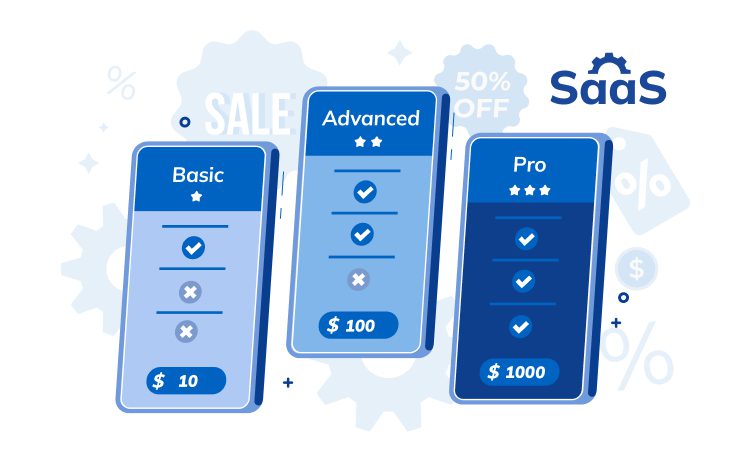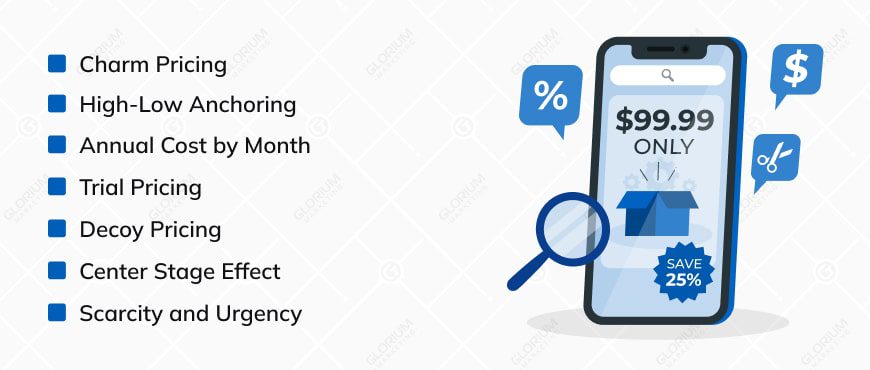
SaaS Pricing Models: Transforming Your Price Into Another Advantage



So, you have this SaaS startup project in the works, and now you face the crossroads of pricing – how to evaluate your product to make it enticing for your prospects and ensure the margin aligns with your efforts. Remember that table of three columns with “Basic,” “Advanced,” and “Pro” plans you saw on a competitor’s website? Well, there is a whole world beyond neatly segmented tiers.
Let’s figure out how to put a price tag on your brainchild. This article is your decoder ring, your map, and your trusty flashlight for illuminating the path to SaaS pricing mastery. We will try to make it simple and provide only essential information so you can start crafting your SaaS pricing right after reading. Let’s turn that pricing puzzle into a masterpiece that makes sense for your startup and leaves your customers cheering for more.
Content
SaaS pricing models are revenue generation models involving software in the cloud. Companies lease the solutions via subscription or via a pay-per-use agreement. There are various ways to package SaaS pricing, and each model has pros and cons. The three most popular pricing models for SaaS are tiered pricing, per-user pricing, and usage-based pricing (UBP). However, we will discover them all.
The key is to match the pricing model with the value provided to customers, ensuring that the price reflects the service’s worth and aligns with the customer’s preferences and usage. When pricing is done right, it can help retain more customers, while a wrong pricing model can lead to decreased conversion rates. A proper SaaS marketing strategy includes a flexible pricing approach that meets different customers’ needs.

Flat rate pricing for SaaS startups involves charging users a fixed fee per month or year for access to all software features. This model simplifies the selection process for customers and makes the product easier to sell. It also allows for easier prediction of churn rate and revenue growth. Yet, this B2B SaaS pricing model has limitations in terms of customization and the potential to discourage prospective customers who seek greater flexibility. Flat rate pricing is less common in mainstream SaaS, with tiered pricing being the de facto model most companies use. While it offers simplicity, it may not be suitable for all SaaS businesses, especially those that require flexibility and the ability to adapt quickly to change.
A nice example of this pricing model is Basecamp – the project management software, which is a prominent champion of flat-rate pricing, offering all features and unlimited users for a single monthly fee. Their target audience of small teams benefits from the predictability and ease of budgeting this model provides.
Tiered pricing for SaaS startups is a subscription billing model that offers several plans at a fixed price, with each tier providing different levels of features or services. This approach is popular among SaaS companies and is often recommended by Glorium Marketing as the best pricing model for most SaaS businesses. Tiered pricing offers several benefits, including:
Some examples of SaaS companies using tiered pricing include Zapier, which offers five tiers ranging from ‘Free’ to ‘Company’, and Zendesk, which has a three-tiered pricing model based on product features. However, it is essential to balance offering enough options to cater to different customer needs without overwhelming them.
Obviously, the per-user pricing model for SaaS startups means customers pay for each user that has personal access to the software. You may start selling your SaaS from 1 user or include a few – depending on your target audience and your product’s capabilities (one user activation might be worth the same load as 3, for instance). Also, this model means the same features and opportunities for every user.
Customers can easily calculate their monthly subscription costs based on the number of users they need. It simplifies the onboarding process for multiple team members, as each user is charged separately.
Some examples of SaaS companies that adopt this pricing model are:
UBP is a SaaS pricing model where customers pay only for what they use, measured by specific metrics like API calls, storage size, or processed data volume. Unlike traditional flat-rate or per-user models, UBP dynamically adjusts costs based on actual consumption, offering several advantages for both startups and customers.
Benefits for SaaS Startups:
Challenges for SaaS Startups:
Companies that use the UBP pricing model:
To determine if UBP suits your startup, ask yourself if your product features can be tracked and priced by usage modules and if the expected usage levels can offset your infrastructure costs.
The freemium model for SaaS startups is a pricing strategy where the basic version of the software is offered for free, with the option to access more advanced features by upgrading to a paid version. This model is popular due to its effectiveness in customer acquisition, with an average conversion rate of 10% and higher for our SaaS clients.
Some benefits of the freemium model for SaaS businesses include effective customer acquisition, product-led growth, and the ability to promote customer retention and user experience.
Examples of SaaS companies that have successfully implemented the freemium model include Dropbox, Hootsuite, Trello, and Spotify.
This model operates on a straightforward premise – users pay a recurring fee at regular intervals, usually monthly or annually, to access the software and its services. The subscription-based pricing model transforms the traditional software purchasing paradigm into an ongoing partnership. Here is how it works:
Users commit to regular payments, often at a fixed rate. This steady income stream enables SaaS companies to plan and allocate resources more efficiently. On the other hand, subscribers gain continuous access to the software and its features for the duration of their subscription. This creates a sense of consistency and reliability for both the provider and the user.
Subscription pricing often comes with different tiers or plans, allowing users to choose the level of service that aligns with their needs. This scalability caters to diverse customers, from individual users to large enterprises.
Advantages:
Considerations:
Many B2B SaaS companies use the subscription-based pricing model, including the streaming giant Netflix, which offers monthly subscriptions for access to its vast library of movies and TV shows; Adobe – offers subscription plans for Photoshop, Illustrator, and InDesign; the cloud-based CRM platform Salesforce with pricing based on the number of users and features; and, of course, Microsoft (subscription plans for its Office suite and cloud-based storage service OneDrive).
The hybrid pricing model for SaaS startups combines two or more distinct pricing models to offer a versatile approach. It is a mix of fixed subscription pricing and UBP, which helps businesses balance the pros and cons of each model. Some benefits of the hybrid pricing model are offering diverse pricing options, catering to different customer needs and preferences, and achieving a balance between stable revenue and additional revenue from usage.
The hybrid enterprise SaaS pricing model is typically employed in subscription-based pricing and is commonly utilized by the same SaaS companies.
Choosing the right SaaS pricing model is a crucial part of your startup marketing strategy. It should align with your product positioning, target audience, and business goals. Here are some key factors to consider when making your choice:

Remember, there’s no one-size-fits-all solution. The best pricing model for SaaS will be a custom blend tailored to your specific product, target audience, and business objectives. Continuously monitor your results, track key metrics, and be willing to adapt and evolve your pricing strategy as you learn and grow.
When it comes to SaaS pricing, it’s not just about the numbers – it’s also about understanding the human mind. Psychological pricing tactics leverage subconscious biases and heuristics to nudge potential customers toward choosing your pricing plans. Here are some effective tactics for SaaS startups:

Charm Pricing
Prices ending in 9 (e.g., $9.99) are perceived as being significantly lower than round numbers ($10), even though the difference is minimal. This is known as the left-digit bias.
High-Low Anchoring
Offer a higher introductory price for a limited time before settling on a lower regular price. This creates a perceived sense of value for the regular price compared to the initial anchor.
Annual Cost by Month
Displaying annual pricing but highlighting the lower monthly equivalent is a smart psychological pricing strategy many SaaS startups use. This tactic can increase yearly subscriptions by up to 20%.
Trial Pricing
Offer a low-cost trial for a limited period to let users experience the value of your SaaS, increasing the likelihood of conversion to a paid plan after the trial ends.
Decoy Pricing
Present three pricing options, with the desired plan priced in the middle and flanked by more expensive or less feature-rich plans. This makes the middle option seem like the most attractive choice.
Center Stage Effect
Visually highlight your preferred pricing plan on the landing page or website. People tend to focus on the center of their visual field, making the highlighted plan more appealing.
Scarcity and Urgency
Use limited-time offers, limited availability for specific plans, or countdown timers to create a sense of urgency and encourage immediate action.
Remember, while these tactics can be effective, ethical considerations are crucial. Avoid being manipulative or deceptive, and always strive to offer real value to your customers. Transparency and building trust are key to long-term success.
SaaS pricing is not a one-time decision but an ongoing process that requires constant testing and optimization. Choosing the right pricing model for your SaaS startup can greatly impact your customer acquisition, retention, and revenue growth. The most popular B2B SaaS pricing models for startups are tiered, per-user, and UBP, as well as subscription-based, freemium, flat rate, and hybrid.
There are many factors to consider when selecting the best SaaS software pricing model, such as your product features, target market, cost structure, and competitive landscape, but you may begin with the following:
You also need to be aware of the psychological aspects of pricing and how they influence customer behavior and perception. Applying the tips and strategies discussed in this article can transform your price into another advantage for your SaaS business.
Are you facing challenges in determining the optimal pricing strategy for your SaaS startup? Glorium Marketing Agency is at your service. Our team of marketers is ready to offer tailored solutions, ensuring a clear understanding of your prospects and seamless conversions for your business.
We provide strategic services that enable you to select the best-fit SaaS pricing model, optimizing revenue while ensuring your clients feel comfortable, avoiding overpayment, and receiving exceptional value. Reach out to us today to explore how we can assist you in achieving your pricing objectives and growing your SaaS startup to new heights!
| Cookie | Duration | Description |
|---|---|---|
| cookielawinfo-checkbox-analytics | 11 months | This cookie is set by GDPR Cookie Consent plugin. The cookie is used to store the user consent for the cookies in the category "Analytics". |
| cookielawinfo-checkbox-functional | 11 months | The cookie is set by GDPR cookie consent to record the user consent for the cookies in the category "Functional". |
| cookielawinfo-checkbox-necessary | 11 months | This cookie is set by GDPR Cookie Consent plugin. The cookies is used to store the user consent for the cookies in the category "Necessary". |
| cookielawinfo-checkbox-others | 11 months | This cookie is set by GDPR Cookie Consent plugin. The cookie is used to store the user consent for the cookies in the category "Other. |
| cookielawinfo-checkbox-performance | 11 months | This cookie is set by GDPR Cookie Consent plugin. The cookie is used to store the user consent for the cookies in the category "Performance". |
| viewed_cookie_policy | 11 months | The cookie is set by the GDPR Cookie Consent plugin and is used to store whether or not user has consented to the use of cookies. It does not store any personal data. |